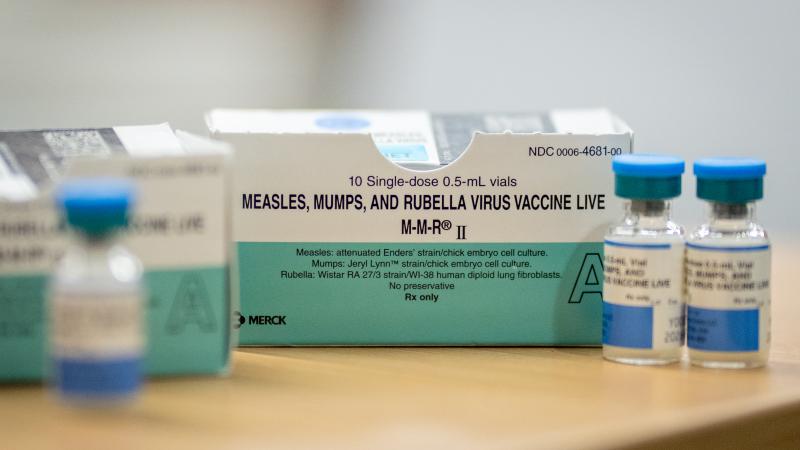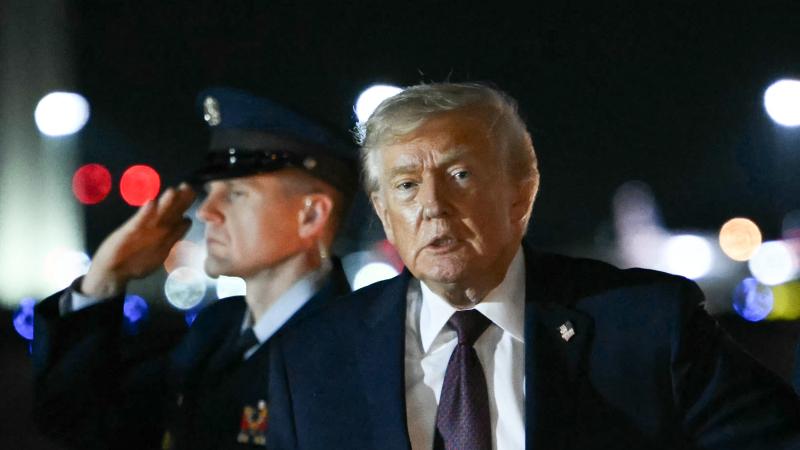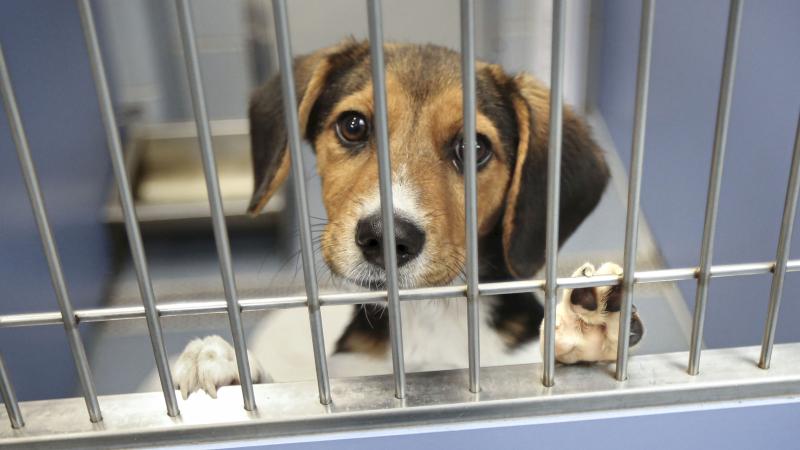Timeline and list of government responses to coronavirus
Here are the actions the federal government has taken in response to the coronavirus pandemic. This will be updated as new information becomes available.
Timeline of Trump's executive actions since January 31, 2020:
- January 31 - President suspends entry of people into the U.S. who pose a risk of transmitting coronaviru and who previously visited China, Hong Kong, and Macau.
- February 29 - Trump suspends entry of people into the U.S. who pose a risk of transmitting coronavirus, who had visited Iran.
- March 11 - President advocates for increase in respirator availability.
- March 11 - Trump suspends entry into U.S. for those who pose a risk of transmitting coronavirus, who had visited the Schengen Area – 26 European states that share open borders.
- March 13 - President declares a national emergency due to COVID-19 outbreak.
- March 13 - Trump orders states to expand diagnostic testing for COVID-19.
- March 14 - Trump suspends immigrant entry to the U.S. for those who pose a risk of spreading COVID-19, who had visited the United Kingdom.
- March 14 - Trump announces a National Day of Prayer for Americans affected by coronavirus.
- March 18 - Executive Order on prioritizing medical resources to prevent COVID-19 spread.
- March 22 - Trump gives the OK for U.S. governors to use the National Guard for COVID-19 support.
- March 23 - President signs Executive Order to prevent hoarding and price gouging.
- March 27: President signs Executive Order allowing Pentagon to activate up to 1 million retired troops.
- March 27: Expansion of domestic production of PPE and ventilators.
- March 28: National Guard support for the Governors of the States of Florida, Louisiana, Maryland, Massachusetts, and New Jersey and the territories of Guam and Puerto Rico.
- March 30: National Guard support for the Governors of the States of Connecticut, Illinois, and Michigan
- April 2nd: Trump declares that supplies to make ventilators be made available to the appropriate companies.
- April 2nd: Trump authorizes the Secretary of Homeland Security to acquire respirators from the appropriate subsidiaries of the 3M Company.
- April 2nd: National Guard support for the Governors of the States of Georgia, Hawaii, Indiana, Missouri, New Hampshire, New Mexico, Ohio, Rhode Island, Tennessee, and Texas and the territory of the U.S. Virgin Islands.
- April 3rd: President takes measures to ensure PPE materials for American doctors remain in the United States.
- April 7th: National Guard support for the Governors of the States of Arizona, Colorado, Kentucky, Mississippi, Montana, Nevada, North Carolina, Oregon, Pennsylvania, South Carolina, Virginia, Wisconsin, and West Virginia
- April 10th: Trump authorizes Sec. of Veterans Affairs to exercise authority to the same extent as someone who is the head of an executive branch when dealing with a coronavirus-related response.
- April 10th: Trump authorizes coronavirus-related aid to Italy
- April 13th: National Guard support for the Governors of the States of Iowa, Kansas, Maine, Nebraska, Oklahoma, and Vermont
- April 19th: Deadlines for import payments are extended
- April 20th: Prior memoranda on National Guard support for various states are extended through May 31st, 2020
- April 22nd: Entry for immigrants who pose a risk to U.S. labor market is suspended
- April 28th: Continued COVID-19 economic support to Governors of various states
- April 28th: Authorization of crisis counseling assistance and training programs for major disaster declarations related to coronavirus
- April 28th: Support for the meat and poultry industry to keep the food supply chain from collapsing
- May 8th: National Guard support for the Governor of South Dakota
- May 19th: Relief for COVID-related economic issues
- May 20th: National Guard support for the Governor of Utah
- May 22nd: Honoring those who died from coronavirus
- May 24th: Suspension and limitation on entry for people who were in Brazil 14 days prior to entering the U.S.
- June 2nd: Continued Federal Support for Governors’ use of the National Guard to respond to COVID-19
- August 3rd: Improving Rural Health and Telehealth Access
- August 6th: Executive order to reduce our dependence on foreign manufacturers for Essential Medicines, Medical Countermeasures, and Critical Inputs
Whole-of-government responses to the pandemic:
- President Trump declared a national emergency, inviting states, territories and tribes to access over $42 billion in existing funding.
- Trump signed legislation securing $8.3 billion for coronavirus response.
- President signed the Families First Coronavirus Response Act, ensuring that American families and businesses impacted by the virus receive the strong support they need.
- To leverage the resources of the entire government, the president created a White House Coronavirus Task Force to coordinate response.
- The Vice President Pence named Dr. Deborah Birx to serve as the White House Coronavirus Response Coordinator.
- President has held multiple teleconferences with our nation’s governors to coordinate response efforts and offer his full support.
Travel restrictions:
- In January, President Trump reacted quickly to implement travel restrictions on travel from China, buying U.S. valuable time to respond to the virus.
- The president has announced further travel restrictions on global hotspots, including Europe, the United Kingdom and Ireland and Iran.
- Americans returning from travel-restricted countries are being routed to specific airports, where they can be screened and isolated as needed.
- The United States reached mutual agreements with Mexico and Canada to restrict non-essential travel across the country's northern and southern borders.
- Administration announced it will expeditiously return illegal immigrants who cross between ports of entry or are otherwise not allowed to enter the country, considering the facilities in which they would be held cannot support quarantine for the time needed to assess potential cases.
- Administration raised travel warnings to their highest level for other hot spot locations such as Japan and South Korea.
- President has expanded airport screenings to identify travelers showing symptoms and instituted mandatory quarantines.
- State Department issued a global, level 4 travel advisory, urging Americans to avoid all international travel due to the coronavirus outbreak worldwide.
Increasing coronavirus testing accessibility:
- The FDA issued emergency approval for new commercial coronavirus tests to significantly expand testing across the country.
- Trump secured legislation that will ensure Americans are able to be tested for free.
- Administration is working with state and local partners and the private sector to open up drive-through testing sites.
- Administration is working with the private sector to develop a website for Americans to determine whether they need a test and, if so, where to get it.
- HHS is providing funding to help accelerate the development of rapid diagnostic tests for the coronavirus.
- FDA cut red tape to expand testing availability.
- Adm. Brett Giroir – the assistant secretary for Health and head of the Public Health Service – has been appointed to coordinate coronavirus testing efforts.
- FDA is empowering states to authorize tests developed and used by laboratories in their states.
- Defense Department has set up 15 coronavirus testing sites worldwide.
- President signed legislation requiring more reporting from state and private labs to ensure our public health officials have the data they need to respond to this outbreak.
- DoD and Department of Health and Human Services worked to airlift hundreds of thousands of swabs and sample test kits from Italy to the United States.
Support for affected by the pandemic:
- Small Business Administration has announced disaster loans that provide impacted businesses with up to $2 million.
- SBA relaxed criteria for disaster assistance loans – expanding small businesses’ access to economic assistance.
- President Trump directed the Energy Department to purchase large quantities of crude oil for the strategic reserve.
- The president has held calls and meetings with business leaders from the pharmaceutical industry, airlines, health insurers, grocery stores, retail stores, banks and more.
- Treasury Department approved the establishment of the Money Market Mutual Fund Liquidity Facility to provide liquidity to the financial system.
Assistance for families and working Americans affected by the pandemic:
- Administration negotiated legislation that will provide tax credits for eligible businesses that give paid leave to Americans affected by the virus.
- Administration took action to provide more flexibility in unemployment insurance programs for workers impacted by the coronavirus.
- Treasury Department moved tax day from April 15 to July 15.
- President Trump signed legislation providing funding and flexibility for emergency nutritional aid for the elderly, women, children and low-income families.
- USDA announced new flexibilities to allow meal service during school closures.
- USDA announced a new collaboration with the private sector to deliver nearly 1 million meals a week to students in rural schools closed due to the coronavirus.
- Administration is halting foreclosures and evictions for families with FHA-insured mortgages.
- Labor Department announced up to $100 million in dislocated-worker grants in response to the coronavirus national health emergency.
- White House worked with the private sector to launch a central website where families, students and educators can access online education technologies.
- Energy Department has given broad approval to colleges and universities to allow them to more easily move their classes online.
- Education Department set interest rates on all federally held student loans to 0% for at least 60 days.
- Education Department announced borrowers will have the option to suspend their payments on federally held student loans for at least two months.
- Education Department is providing waivers for federal testing requirements to states that have had to close schools.
Informing the public:
- Administration launched a website – coronavirus.gov – to keep the public informed about the outbreak.
- President Trump launched a partnership with the Ad Council, media networks, and digital platforms to communicate public services announcements about the coronavirus.
- President announced guidelines for Americans to follow and do their part to stem the spread of the virus.
- The White House Coronavirus Task Force is holding nearly daily press conferences to provide the American people with the latest information.
- Task force has recommended mitigation strategies to heavily impacted communities, like those in California, New York and Washington.
- Centers for Medicare and Medicaid Services announced guidance to protect vulnerable elderly Americans and limit medically unnecessary visits to nursing homes.
Supporting patients and healthcare providers:
- In January, the administration declared the coronavirus to be a public health emergency.
- President donated his fourth-quarter 2019 salary to the Department of Health and Human Services for coronavirus response efforts.
- Trump took action to give HHS authority to waive rules and regulations so that healthcare providers have maximum flexibility to respond to this outbreak.
- CMS is giving flexibility to Medicare Advantage and Part D plans to waive cost-sharing for coronavirus tests and treatment.
- CMS created new billing codes for coronavirus tests to promote better tracking of the public health response.
- White House Office of Science and Technology Policy coordinated with the National Institutes of Health, the tech industry and nonprofits to release a machine-readable collection of 29,000 coronavirus-related research articles, which will help scientists discover insights into the virus’ genetics, incubation, treatment, symptoms and prevention.
- Administration announced that health plans with health savings accounts will be able to cover coronavirus testing and treatment without co-payments.
- CMS dramatically expanded telehealth for Medicare beneficiaries, ensuring more patients can access their doctors remotely while avoiding exposure.
- HHS lifted HIPAA penalties to enable healthcare providers to expand telehealth access for patients.
- The VA established 19 emergency operations centers across the country and put in place visitation restrictions to limit patients’ exposure.
- CMS and Department of Veterans Affairs are working to limit nonessential, elective medical procedures to free up healthcare resources.
- U.S. Navy will be deploying two medical ships to help support impacted areas.
- President announced Carnival Cruise Lines will be making ships available for hospitals to use for non-coronavirus patients.
Strengthening essential medical supplies:
- The President announced he is invoking the Defense Production Act.
- The President signed a memorandum directing his Administration to make general-use face masks available to healthcare workers.
- HHS announced it will be purchasing 500 million N95 respirators for the Strategic National Stockpile.
- Defense Department announced it will be providing 5 million respirator masks and 2,000 specialized ventilators to assist.
- President signed legislation removing restrictions that prevented manufacturers from selling industrial masks – which can readily protect healthcare workers – directly to hospitals.
Developing vaccines and therapeutics:
- Administration is working to help accelerate the development of therapeutics and a vaccine to combat the coronavirus.
- FDA is evaluating existing drugs that could serve as potential therapeutics for coronavirus patients.
- Administration is actively working with drug manufacturers to monitor any potential drug supply chain issues.
- Administration is expanding research and consulting with experts to better understand the transmission of coronavirus.
- NIH has announced the beginning of a clinical trial for a coronavirus vaccine candidate.
The Facts Inside Our Reporter's Notebook
Links
- President suspends entry of people into the U.S. who pose a risk of transmitting coronaviru and who previously visited China, Hong Kong, and Macau.
- Trump suspends entry of people into the U.S. who pose a risk of transmitting coronavirus, who had visited Iran.
- President advocates for increase in respirator availability.
- Trump suspends entry into U.S. for those who pose a risk of transmitting coronavirus, who had visited the Schengen Area â 26 European states that share open borders.
- President declares a national emergency due to COVID-19 outbreak.
- Trump orders states to expand diagnostic testing for COVID-19.
- Trump suspends immigrant entry to the U.S. for those who pose a risk of spreading COVID-19, who had visited the United Kingdom.
- Trump announces a National Day of Prayer for Americans affected by coronavirus.
- Executive Order on prioritizing medical resources to prevent COVID-19 spread.
- Trump gives the OK for U.S. governors to use the National Guard for COVID-19 support.
- President signs Executive Order to prevent hoarding and price gouging.
- President signs Executive Order allowing Pentagon to activate up to 1 million retired troops.
- Expansion of domestic production of PPE and ventilators.
- National Guard support for the Governors of the States of Florida, Louisiana, Maryland, Massachusetts, and New Jersey and the territories of Guam and Puerto Rico.
- National Guard support for the Governors of the States of Connecticut, Illinois, and Michigan
- Trump declares that supplies to make ventilators be made available to the appropriate companies.
- Trump authorizes the Secretary of Homeland Security to acquire respirators from the appropriate subsidiaries of the 3M Company.
- National Guard support for the Governors of the States of Georgia, Hawaii, Indiana, Missouri, New Hampshire, New Mexico, Ohio, Rhode Island, Tennessee, and Texas and the territory of the U.S. Virgin Islands.
- President takes measures to ensure PPE materials for American doctors remain in the United States.
- National Guard support for the Governors of the States of Arizona, Colorado, Kentucky, Mississippi, Montana, Nevada, North Carolina, Oregon, Pennsylvania, South Carolina, Virginia, Wisconsin, and West Virginia
- Trump authorizes Sec. of Veterans Affairs to exercise authority to the same extent as someone who is the head of an executive branch when dealing with a coronavirus-related response.
- Trump authorizes coronavirus-related aid to Italy
- National Guard support for the Governors of the States of Iowa, Kansas, Maine, Nebraska, Oklahoma, and Vermont
- Deadlines for import payments are extended
- Prior memoranda on National Guard support for various states are extended through May 31st, 2020
- Entry for immigrants who pose a risk to U.S. labor market is suspended
- Continued COVID-19 economic support to Governors of various states
- Authorization of crisis counseling assistance and training programs for major disaster declarations related to coronavirus
- Support for the meat and poultry industry to keep the food supply chain from collapsin
- National Guard support for the Governor of South Dakota
- Relief for COVID-related economic issues
- National Guard support for the Governor of Utah
- Honoring those who died from coronavirus
- Suspension and limitation on entry for people who were in Brazil 14 days prior to entering the U.S.
- Continued Federal Support for Governorsâ use of the National Guard to respond to COVID-19
- Improving Rural Health and Telehealth Access
- Executive order to reduce our dependence on foreign manufacturers for Essential Medicines, Medical Countermeasures, and Critical Inputs
- coronavirus.gov
















